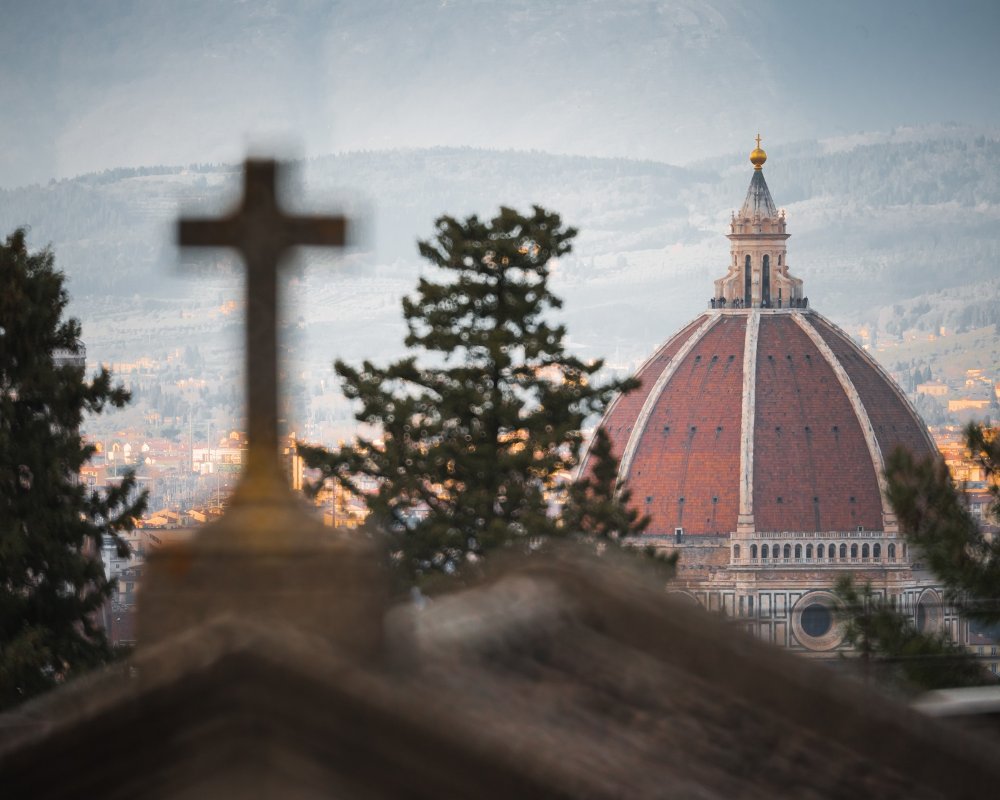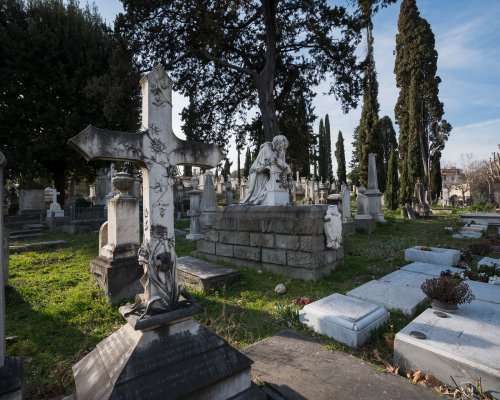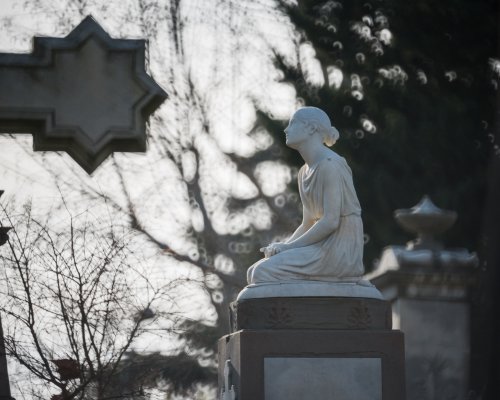Discovering the three Florentine monumental cemeteries, true open-air museums
The monumental cemeteries of a city like Florence are places to visit. While perhaps less known, they contain certain surprises. In fact, in the city, there are three cemetery that preserve the statues and burials of well-known people of the past, in a sort of open-air gallery.
Florence was the favorite destination of the Grand Tour and the chosen homeland for many people from overseas or from northern Europe between the nineteenth and early twentieth centuries, thus non-Catholic cemeteries were needed. The first to be built was the cemetery in Piazza Donatello, known as the English cemetery. This was followed by the Cimitero degli Allori along the road that leads out of the city towards Siena. These became the burial places for many "adopted Florentines". It's fascinating to imagine the lives of the people depicted in the sarcophagi or statues, as was in vogue at that time and harks back to Romanticism and Neoclassicism.
On the other hand, the Cimitero delle Porte Santo (Cemetery of the Holy Doors) is Catholic and lies below the Abbazia of San Miniato al Monte. Here, a number of names from the world of culture and politics have their eternal rest.
The English Cemetery in Florence is an oasis of peace in the middle of heavily-trafficked crossroads in a ring of bypass roads.
In a raised position above the ground on an artificial hill, this monumental cemetery holds the remains of those who, English or not, did not belong to the Catholic faith. Between 1828 and 1878, numerous prominent figures such as the poet Elizabeth Barrett Browning, Walter Savage Landor, Fanny Trollope and even Gian Pietro Vieusseux were buried here.
The cemetery, with its tombs adorned with statues and surrounded by trees has a typically nineteenth-century aesthetic and romantic taste, representing sheer tranquility that can be visited with free admission.
A curiosity: it seems that the cemetery, with its rounded and raised shape, was the inspiration for one of Arnold Boecklin's most famous paintings, the Isle of the Dead. In this cemetery, which Boecklin saw from his Florentine home, his daughter was also buried. The Swiss artist spent a period in Florence starting in 1894 and died on the hill of Fiesole in 1901.
The English Cemetery in Florence is an oasis of peace in the middle of heavily-trafficked crossroads in a ring of bypass roads.
In a raised position above the ground on an artificial hill, this monumental cemetery holds the remains of those who, English or not, did not belong to the Catholic faith. Between 1828 and 1878, numerous prominent figures such as the poet Elizabeth Barrett Browning, Walter Savage Landor, Fanny Trollope and even Gian Pietro Vieusseux were buried here.
The cemetery, with its tombs adorned with statues and surrounded by trees has a typically nineteenth-century aesthetic and romantic taste, representing sheer tranquility that can be visited with free admission.
A curiosity: it seems that the cemetery, with its rounded and raised shape, was the inspiration for one of Arnold Boecklin's most famous paintings, the Isle of the Dead. In this cemetery, which Boecklin saw from his Florentine home, his daughter was also buried. The Swiss artist spent a period in Florence starting in 1894 and died on the hill of Fiesole in 1901.
The Cimitero dell Porte Sante (Cemetery of the Holy Doors) is a monumental cemetery built in the second half of the nineteenth century in a panoramic position at the foot of the Abbazia of San Miniato al Monte. Open to visitors, it's a place where you can absorb a solemn and serene atmosphere.
Beginning from the 1870s, the tombstones were enriched with crosses, vases, statues and funeral chapels were created for various families.
The cemetery houses the burials of important public figures, active on the cultural or political scene in Florence, but known far beyond the city limits. Among these are the tombs of Carlo Lorenzini or Collodi, the author of Pinocchio, writer Vamba, Vasco Pratolini and Giuseppe Papini.
Artists buried here include Ottone Rosai, Libero Andreotti and the director Franco Zeffirelli. The Vespucci family tomb is also to be found here.
The Cimitero dell Porte Sante (Cemetery of the Holy Doors) is a monumental cemetery built in the second half of the nineteenth century in a panoramic position at the foot of the Abbazia of San Miniato al Monte. Open to visitors, it's a place where you can absorb a solemn and serene atmosphere.
Beginning from the 1870s, the tombstones were enriched with crosses, vases, statues and funeral chapels were created for various families.
The cemetery houses the burials of important public figures, active on the cultural or political scene in Florence, but known far beyond the city limits. Among these are the tombs of Carlo Lorenzini or Collodi, the author of Pinocchio, writer Vamba, Vasco Pratolini and Giuseppe Papini.
Artists buried here include Ottone Rosai, Libero Andreotti and the director Franco Zeffirelli. The Vespucci family tomb is also to be found here.
Opened in 1878 by the Florentine evangelical churches, it was used to give burial to non-Catholics who were not able to be buried in the cemeteries of the city, especially after the closure of the English Cemetery following the law that decreed a minimum distance of 100 meters from the inhabited center.
Here rest many great names in collecting and art history: from Frederik Stibbert to Sir Harold Acton, from Roberto Longhi to John Pope Hennessy to Herbert Percy Horne; but also artists, such as the Swiss painter Arnold Boecklin, the architect Leonardo Savioli and the German painter Hans-Joachim Staude.
There are also many women buried here, artists, intellectuals, writers such as Oriana Fallaci, Ludmilla Assing, Jessie Taylor Hillebrand, Vernon Lee, Elizabeth Boott Duveneck, Sofia Besobrasova De Gubernatis and Dorothy Nevile Lees. Alongside them are many other great names, but also lesser known figures that are no less worthy of being commemorated.
The cemetery offers itself as a testimony, a document of life, a monument of art, a real open-air museum for the significant pieces of sculpture and applied arts between the nineteenth and twentieth centuries. The most important Tuscan sculptors have left their traces there, such as Fantacchiotti, Romanelli, Betti, Costoli, Maraini and alongside them the foreign sculptors who had chosen to live in Florence such as Adolf von Hildebrand. The sculpted marbles document the trends of purist academic language and realism, Art Nouveau, Symbolism, Déco, articulated in a refined inventory of styles.
Opened in 1878 by the Florentine evangelical churches, it was used to give burial to non-Catholics who were not able to be buried in the cemeteries of the city, especially after the closure of the English Cemetery following the law that decreed a minimum distance of 100 meters from the inhabited center.
Here rest many great names in collecting and art history: from Frederik Stibbert to Sir Harold Acton, from Roberto Longhi to John Pope Hennessy to Herbert Percy Horne; but also artists, such as the Swiss painter Arnold Boecklin, the architect Leonardo Savioli and the German painter Hans-Joachim Staude.
There are also many women buried here, artists, intellectuals, writers such as Oriana Fallaci, Ludmilla Assing, Jessie Taylor Hillebrand, Vernon Lee, Elizabeth Boott Duveneck, Sofia Besobrasova De Gubernatis and Dorothy Nevile Lees. Alongside them are many other great names, but also lesser known figures that are no less worthy of being commemorated.
The cemetery offers itself as a testimony, a document of life, a monument of art, a real open-air museum for the significant pieces of sculpture and applied arts between the nineteenth and twentieth centuries. The most important Tuscan sculptors have left their traces there, such as Fantacchiotti, Romanelli, Betti, Costoli, Maraini and alongside them the foreign sculptors who had chosen to live in Florence such as Adolf von Hildebrand. The sculpted marbles document the trends of purist academic language and realism, Art Nouveau, Symbolism, Déco, articulated in a refined inventory of styles.


